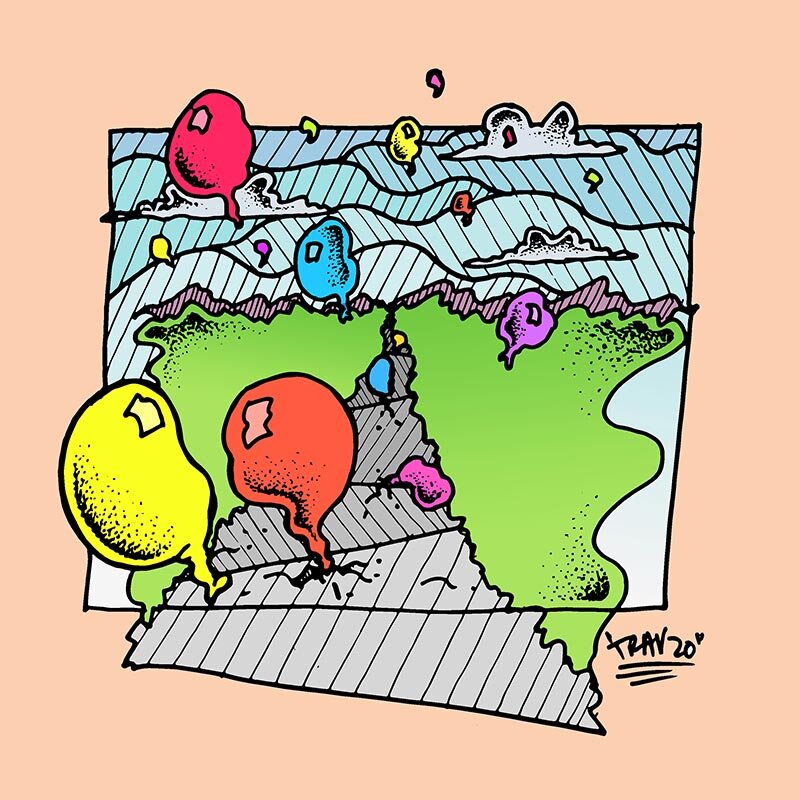Balloons Might One Day Become Extinct
With helium shortages already a problem, the future of balloons is up in the air.
By Riley Blake
Artist: Trav
Balloons, the iconic party flare, have added whimsy to events and holidays for nearly two centuries.
However, if current trends continue and resources are depleted, there’s a strong possibility that helium-filled balloons may vanish entirely from existence, or at least become incredibly expensive.
While balloons can be traced back to the Renaissance, when pig bladders were used as inflation devices, the first rubber balloon wasn’t invented until 1824 by British scientist Michael Faraday.
Using hydrogen to expand it, he discovered that covering the inner lining of the balloon with flour helped prevent the sides from collapsing and sticking together. Faraday’s discovery quickly caught the attention of rubber manufacturer, Thomas Hancock, who introduced do-it-yourself kits to the market, complete with rubber solution and a condensing syringe. It wasn’t until the turn of the nineteenth century that the balloon fad floated over to America, introducing a whole new market to the inflatable party prop.
But though balloons filled with hydrogen float, they’re also highly flammable, which eventually led salesmen to switch to another inflammable gas: helium.
In our universe, helium — the property most known for inflating balloons and blimps — is abundant. Named after the greek sun god Helios, it happens to be the second most common element in our expanded galaxy. But it’s a different story on Earth.
Here, helium is relatively rare and depleting at rapid rates. Over time, its cost has risen steadily, with industry experts observing price hikes of 50% to as much as 100% from one year to the next. With some scientists believing that the noble gas will be gone in the next 25 to 30 years, balloons might one day be just an idea from the past.
What is helium?
Helium is the second element on the periodic table and is normally found alongside natural gas. It is released through the slow radioactive decay of heavy elements, such as uranium and thorium, and found deep underground.
Small amounts of helium do rise through the Earth’s crust and eventually enter space, but the majority is trapped beneath layers of rock, intermingled with other natural gases.
How to get helium
Helium is mined alongside natural gas using a drill rig that burrows deep inside the Earth’s crust. Once the rig reaches the gases, the helium and natural gas are collected and transported through a piping system to refining plants for separation.
The helium problem
Even though helium has a number of different uses, balloons are being blamed as the main culprit for the gas’ disappearance. Necessary for MRI scanners, welding, military surveillance blimps, and the fiber optic cables that bring us high-speed internet, the necessity of party balloons pales in comparison.
Ava Price, 24, has worked at the Paper Caper Party Supply Store in Lake Oswego, Oregon for five years, where she has experienced firsthand the fluctuating supplies of helium.
“We’ve had helium shortages in the past,” Price told OK Whatever. “Last year it was worse than it is now. It happened during our balloon ‘slow season’ (between the Fourth of July and Halloween), but the price of helium went up.”
Not only is there less helium in the Earth’s crust, but separating it from other natural gases has become unprofitable as well.
Moses Chan, Evan Pugh Professor of Physics at Penn State, spoke with phys.org about the depleting resource:
"Very few natural gas wells in the world have enough helium in the well to make it economical to separate helium from natural gas. The gas wells with the most helium have only about 0.3%, so it is in short supply."
Helium-filled balloons begin to become problematic when contrasted to more necessary devices, like MRI scanners. Livescience.com reports that 28% of the world’s helium is used for high-field magnets, an integral part of making MRI scanners functional. Another 13% of the world’s helium is used in cooling processes for fiber optics and semiconductors due to the element’s non-volatile nature and low liquid-temperature.
Party balloons only come in at 7% of helium usage. But once the party’s over and the balloons pop or deflate, the gas rises and the helium is unable to be recovered.
If Robert Richardson, a physicist and Nobel prize laureate from Cornell University, had it his way, balloons would “cost about $100 apiece based on current helium supply."
Though the price of balloons is rising, they cost nowhere near as much as Richardson would like.
In the half-decade that she has worked at the party supply store, Price considers balloons only “a little bit more expensive” than when she started, estimating no more than a 25% increase in their price over the years.
“Our latex balloons used to be $2.00. Now they’re $2.50,” Price gave as an example.
While the price increase may not seem like much, the market remains in limbo as sporadic shortages continue.
“It’s not having an effect [at the moment]. But it’s possible it could start next shipment,” Price said. “I know that helium is used in MRI machines and other medical practices so of course it’s going to go to that first instead of balloons.”
So what will happen to balloons when we run out of helium? The outlook is not good.
There is currently no other known solution that can be used to keep a balloon afloat in the same way that helium does. Granted, one could always return to using hydrogen to fill their balloons, like they did in the past, but combustible party decor is probably a hard sell for most customers.
If a safer, more plentiful alternative for filling balloons is not found, we might one day lament those silly plastic bags filled with air that we took for granted. There’s a possibility something will come along and fill the void, but until that time, the future of the balloon is still up in the air.













